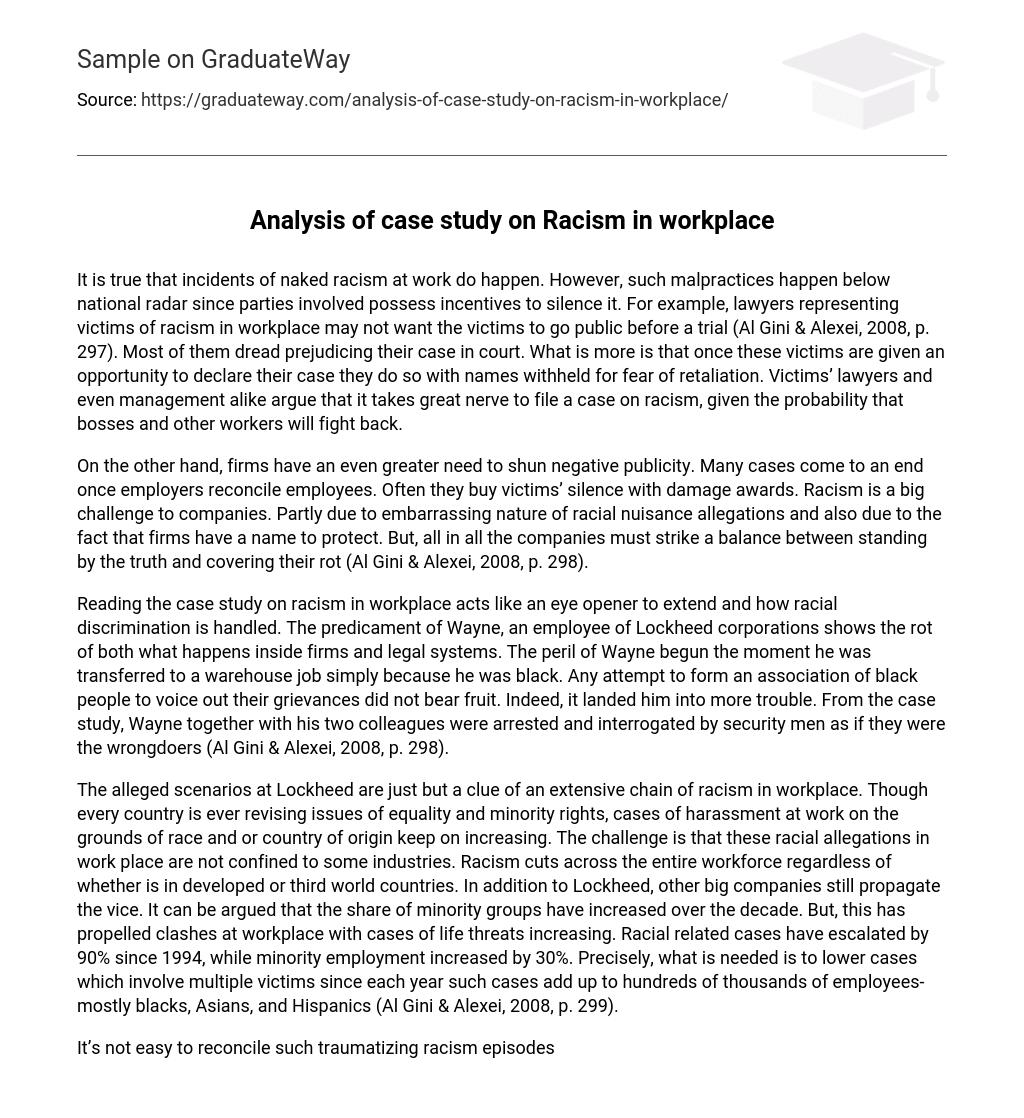It is true that incidents of naked racism at work do happen. However, such malpractices happen below national radar since parties involved possess incentives to silence it. For example, lawyers representing victims of racism in workplace may not want the victims to go public before a trial (Al Gini & Alexei, 2008, p. 297). Most of them dread prejudicing their case in court. What is more is that once these victims are given an opportunity to declare their case they do so with names withheld for fear of retaliation. Victims’ lawyers and even management alike argue that it takes great nerve to file a case on racism, given the probability that bosses and other workers will fight back.
On the other hand, firms have an even greater need to shun negative publicity. Many cases come to an end once employers reconcile employees. Often they buy victims’ silence with damage awards. Racism is a big challenge to companies. Partly due to embarrassing nature of racial nuisance allegations and also due to the fact that firms have a name to protect. But, all in all the companies must strike a balance between standing by the truth and covering their rot (Al Gini & Alexei, 2008, p. 298).
Reading the case study on racism in workplace acts like an eye opener to extend and how racial discrimination is handled. The predicament of Wayne, an employee of Lockheed corporations shows the rot of both what happens inside firms and legal systems. The peril of Wayne begun the moment he was transferred to a warehouse job simply because he was black. Any attempt to form an association of black people to voice out their grievances did not bear fruit. Indeed, it landed him into more trouble. From the case study, Wayne together with his two colleagues were arrested and interrogated by security men as if they were the wrongdoers (Al Gini & Alexei, 2008, p. 298).
The alleged scenarios at Lockheed are just but a clue of an extensive chain of racism in workplace. Though every country is ever revising issues of equality and minority rights, cases of harassment at work on the grounds of race and or country of origin keep on increasing. The challenge is that these racial allegations in work place are not confined to some industries. Racism cuts across the entire workforce regardless of whether is in developed or third world countries. In addition to Lockheed, other big companies still propagate the vice. It can be argued that the share of minority groups have increased over the decade. But, this has propelled clashes at workplace with cases of life threats increasing. Racial related cases have escalated by 90% since 1994, while minority employment increased by 30%. Precisely, what is needed is to lower cases which involve multiple victims since each year such cases add up to hundreds of thousands of employees-mostly blacks, Asians, and Hispanics (Al Gini & Alexei, 2008, p. 299).
It’s not easy to reconcile such traumatizing racism episodes with a culture that is more agreeing with its escalating diversity than ever before. Currently, immigrants from all racial and ethnic background floods for instance to U.S. in U.S there is a middle class for solid black, and gives room for all minorities, from academic to workplace issues. Thinking about race makes one grapple with more complex and subtle issues like whether embracing affirmative action is still vital in assisting minorities overcome past instances of discrimination, or whether it often constitutes push back discrimination in working place based on race (Al Gini & Alexei, 2008, p. 299).
Basically, discrimination on grounds of racism is a vice which calls for attention of every individual, country, or continent. Now is no time for deliberating whether racism is right or wrong. From the episodes of past decades every stakeholder knows that it is wrong to mistreat an individual, and or group based on race. It is the high time to fix it once and for all. Eliminating racism among organizations means freedom and high productivity. It is unanimously agreed that there are rules in place to prevent furtherance of racism in workplace. What is more is to lay down ways to ensure the same is implemented. In this light an individual or management that is found still propagating racism must be dealt with otherwise the vice will remain. In addition, an individual, manager, or organization of substance must not continue either directly or indirectly to promote racism in the working place. Company laws must be tailored in a way so as to ensure equality at work place is enhanced. In other words, the question of who is supposed to hold a given office must be based on merit and not race. In this way one can be assured of a reliable and well balanced work environment. Racism makes one feel unqualified, guilty, and discriminated. Victims also feel intimidated and lacking as far as professionalism is concerned.
In conclusion, from the case study it is clear that incidents of racism are real. Over the last decade racism has been on the rise with individuals and organization enhancing it. Legal systems must be strengthened to prevent and eliminate racism in workplace. Finally, not until employers confront the issue head on, racism will never end.
References
- Al Gini. & Alexei, M. (2008), Case Studies in Business Ethics, 6th ed. Prentice Hall: Pearson Ed. Publishers.





